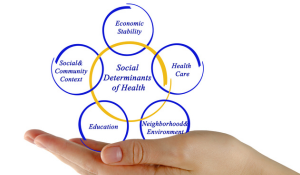 The question of why the virus has overwhelmed some places and left others relatively untouched is a puzzle that has spawned numerous theories and speculations but no definitive answers. That knowledge, however, could have profound implications for how states, counties, and municipalities respond to the virus, for determining who is at risk and for knowing when it’s safe to go out again.
The question of why the virus has overwhelmed some places and left others relatively untouched is a puzzle that has spawned numerous theories and speculations but no definitive answers. That knowledge, however, could have profound implications for how states, counties, and municipalities respond to the virus, for determining who is at risk and for knowing when it’s safe to go out again.
The social workers we have talked to tell us that addressing the social determinants that affect the health of the most vulnerable populations is a research point-of-departure. They submit that the impact of so-called Social Determinants of Health on outcomes can’t be overstated.
In trying to understand the capricious nature of the current corona virus pandemic, they reference two diverse sub-cultural groups that have suffered disproportionately worse outcomes of the pandemic, African Americans in large eastern cities and the Navajo Nation in Arizona, Utah, and New Mexico. By isolating the factors that separate these cultural groups from their neighboring populations, social workers are trying to determine how the social determinants of health fuel this deadly contagion.
Social Determinants of Health
The conditions in which we live explain, in part, why some Americans are healthier than others and why Americans more generally are not as healthy as they could be. This is the fundamental premise behind the concept of social determinants of health.
Research into the impact of socioeconomic factors and cultural predispositions on the health of sub-cultural populations has been going on for many years. The findings break down into the following areas of impact:
- 40% socioeconomic factors + 10% physical environment factors = 50% of the total social determinants.
- This 50% is broken down into:
- Transportation
- Housing
- Income
- Education
- Food Access
- 30% attributable to predisposed health behaviors.
- 20% to healthcare access and quality.
Social workers are looking at the covid-19 pandemic through the lens of the factors above to isolate those that contributed to the unusually high incidence of infection and death in the African American community and the Navajo Nation.
The African American Community
The disproportionate impact of the COVID-19 crisis in the African American community is principally explained by three factors:
- The cultural memory of African Americans, specifically distrust of the medical profession, causes this community to avoid medical treatment rather than seek it out.
- The socioeconomic factors.
- They live in comparatively large family units.
- Because they grew up in and still live in urban neighborhoods, they are indifferent to social distancing guidelines.
- They adhere to myths about youth and religion serving as protective factors from coronavirus.
- African Americans are disproportionately essential workers.
The Navajo Nation
Like African Americans, Navajos are suffering a disproportionately high rate of coronavirus fatalities, twice the national per capita rate, according to Navajo Department of Health data. COVID-19 fatalities on the reservation last week overtook those recorded in the entire state of New Mexico, according to health authority figures.
Preliminary analysis by the social work community reveal the following SDOH on the Navajo reservation:
- The tribe, who refer to themselves as the Diné, has high rates of diabetes, heart disease and obesity - underlying conditions that increase risk of severe complications from COVID-19, according to the U.S. Centers for Disease Control.
- The pandemic has shown stark inequalities in healthcare, housing and basic services between the Navajo Nation and the states of New Mexico, Utah and Arizona, which it straddles, according to six tribal leaders interviewed by Reuters.
- The Navajo Epidemiology Center says the close proximity of families living in homesteads or public housing has driven community spread.
- With a land mass as big as West Virginia, the reservation has only 13 small grocery stores and 40% unemployment. That forces residents to drive hundreds of miles to cities such as Farmington, New Mexico and Phoenix, Arizona for work and supplies. One member’s travel can infect an entire family, Navajo leaders warn.
Only a Start
These findings are only a start. Social service professionals are working tirelessly to support vulnerable populations during this time of crisis and will continue the work of education and support long after the lights have gone out on this current pandemic.

